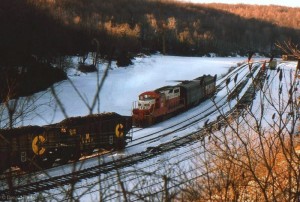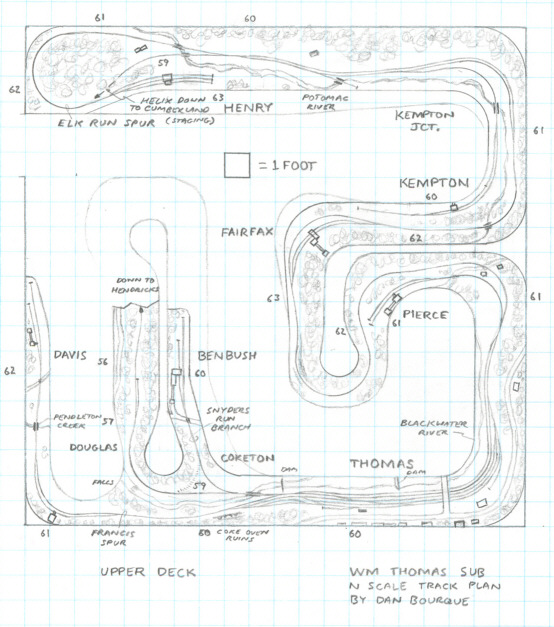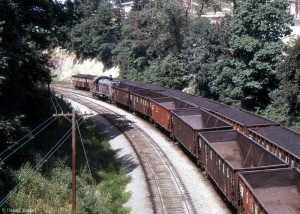- Size: 20′ x 20′
- Scale: N
- Minimum Radius: 18″
- Minimum Aisle Width: 30″
- Designed by Dan Bourque
 The heart of the WM’s coal fields was Elkins, WV. The yard at Elkins was the sending and gathering point for mine runs and locals working the four lines west including the B&O connection to Belington, WV, the branch to Mill Creek, WV, the winding line to Webster Springs, WV and the branch to a connection with the C&O at Durbin, WV. These lines supplied the WM with loads of coal and lumber products. From Elkins, the loads needed to move 110 miles to the WM’s Knobmount Yard in Cumberland, WV. The line that connected Elkins and Cumberland was the Thomas Sub. While it may look like a straightforward run on a map, one look at the grade profile tells a different story. Rather than wind across the mountains to climb the ridge near Thomas, WV, the WM’s line ran up the steeper grade of the Blackwater Canyon. The “Black Fork Grade” through the canyon from Hendricks to Thomas had a whopping 3.05% ruling grade with bits of 3.75% mixed in.
The heart of the WM’s coal fields was Elkins, WV. The yard at Elkins was the sending and gathering point for mine runs and locals working the four lines west including the B&O connection to Belington, WV, the branch to Mill Creek, WV, the winding line to Webster Springs, WV and the branch to a connection with the C&O at Durbin, WV. These lines supplied the WM with loads of coal and lumber products. From Elkins, the loads needed to move 110 miles to the WM’s Knobmount Yard in Cumberland, WV. The line that connected Elkins and Cumberland was the Thomas Sub. While it may look like a straightforward run on a map, one look at the grade profile tells a different story. Rather than wind across the mountains to climb the ridge near Thomas, WV, the WM’s line ran up the steeper grade of the Blackwater Canyon. The “Black Fork Grade” through the canyon from Hendricks to Thomas had a whopping 3.05% ruling grade with bits of 3.75% mixed in.
The Black Fork Grade meant every loaded train required helpers. Through most of the steam era, helpers for the grade were stationed at Thomas and picked up their trains at Hendricks. Toward the end of the steam era and through the diesel era, helpers were based at Elkins and ran all the way from Elkins to Thomas. Tight curves on the line meant nothing larger than a Consolidation in the steam era and 4 axles in the diesel era. Most trains had both mid-train and rear-end helpers making for trains using 7 Consolidations or 10 diesels (RS3s, F-units and geeps) to get up the grade. Helpers were normally cut off at Thomas, but for heavy trains, the helpers would be repositioned to the rear of the train at Thomas for a quick shove up to the crest of the hill at Fairfax.
Thomas was also a base for mine runs working a handful of short branches nearby. The WM served loaders on the Francis Branch from Thomas to Davis, the Snyders Run Branch from Coketon to Benbush, the short branch to Pierce, the Kempton Branch and the Elk Run Spur. These lines were pretty sleepy in the diesel era, but they still provided a consistent flow of coal hoppers to the mainline, most of which went east toward Cumberland. Other online industries along the Thomas Sub included lumber products, a tannery and Kingsford Charcoal just west of Parsons.
The Layout
Just because it’s N-scale doesn’t mean the layout has to be small. This layout represents the Thomas Sub from the transition era throughout the diesel era. The focus of the layout is the grade from Elkins to Thomas. Most of Elkins Yard, to include the classic roundhouse, is represented, though some of the shop and storage tracks in the middle of the yard have been omitted. The lines west of Elkins are represented by staging, and the tracks duck behind the backdrop before the series of splits and wyes leading to the various branches. A bit of the rolling farm country east of Elkins is represented, but a one-turn helix “eats” a lot of the mainline between Elkins and Parsons. Parsons and Hendricks are well represented. The upper deck is centered on Thomas. All of the coal branches are represented, though the track arrangements on each branch are somewhat guesswork (I only have track charts for the main). For the most part, the mainline and branches share common scenery, but the real branches didn’t run too far from the main anyway.
The Black Fork Grade is the focus of the layout. The Blackwater Canyon occupies its own penninsula, and it is the only portion of the layout that is single-decked. The steep grade actually takes the place of a helix and allows a train to transit over the entire visible portion of the layout without being hidden (other than the one-turn helix near Parsons). This also allows helpers to be run without “losing” the train in excessive hidden track. The short grade from Elkins to Haddix (helix) has been omitted, but otherwise, the grades on the layout closely match those on the prototype. Staging is not represented in detail, but there is sufficient room for three staging yards. There are two stub-ended yards for east (Cumberland) and west (Belington, Webster Springs, Durbin) staging. The main staging yard, however, is double-ended and located under Elkins. This yard forms a continuous running loop and represents both east and west–it can be used to “recycle” coal trains during a session to create more operation without more equipment.
Another nice feature of this track plan is the way the track “switches” orientations as it changes from the lower to the upper deck. On the lower deck, right is east, and the rivers are to the front and hills to the back. Blackwater Canyon can be modeled prototypically with lots of scenery above and below the track which kind-of “hangs on” to the hillside. However, at Douglas, the orientation changes, and the Francis Branch is evident on the hillside across the river from the main, just as on the prototype. At Thomas, while left is now east, the water is once again to the front of the layout and the hills to the back again, both prototypical.
Lower Deck
Upper Deck
Operations
This layout could easily support 5-7 operators or it could be run by one person. DCC with walkaround control is a must for reliable helper operations in N-scale, and a full-featured throttle to make it easy to make and break consists would be very beneficial. Crew positions would include a dispatcher, Elkins yardmaster, 1-2 helper crews, and 2-3 road crews. Operations would consist primarily of moving coal loads east from Elkins to Cumberland (staging) and empties west. Coal loads would be brought into Elkins from staging, and yardmaster would block them into trains and add helpers (mid-train and rear, if you’re adventurous). Even a short train of 25-30 cars could justify 5-6 locomotives for the Black Fork Grade. A road crew and helper crew would move the train east to Hendricks to assault the grade. Upon arrival at Thomas, the helpers would be cut out for the return run to Elkins, though on occasion, a train might also need a quick shove over the summit at Fairfax.
Meanwhile, another road crew would bring empties in from Cumberland staging and run them down the grade into Elkins. Passing sidings at Henry, Thomas, Hendricks and Parsons could be used to meet eastbounds. The crew would park their locomotives for servicing and a return trip up the grade. The Elkins yardmaster would break down the train and block it for mine runs to the branches west of Elkins. Various turns would also depart daily from Elkins to work the industries and tipples between Elkins and Henry. A Parsons turn might work Kingsford Charcoal, US Leather Company and Parsons Forest Products in and around the Parsons/Hendricks area. A Thomas turn might be used to take coal loads and empties to the yard at Thomas, and the East Local would switch the yard at Thomas and work industries and tipples on the upper deck. Other turns might come from Cumberland to swap out empties for loads at Henry siding and Thomas.
Any way you look at it, this layout would have a great combination of scenic possibilities, mainline operations, helpers, mine runs and switching.
Things I Like About this Plan:
- Long helper run with little hidden track
- Mostly prototypical grades and track arrangements throughout
- Good mix of operations
- Includes all the branches around Thomas (and on the correct sides of the main)
- Big yard and engine facilities at Elkins
- No helix between lower and upper decks (only helix to staging)
- Two main switching spots, Elkins and Thomas, are on separate aisles (avoids crowding)
Things I Don’t Like About this Plan:
- Elkins to Parsons is very compressed
- Little height difference between decks at Hendricks/Thomas
- Long reach to roundhouse at Elkins
- A few 30″ “pinch points” on the aisles
Related Products:







